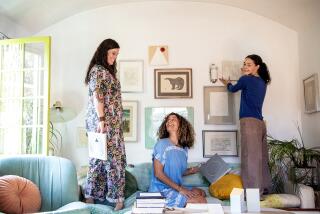Putting Your Home in Flattering Light
- Share via
If your home is a stage for life, then think of good lighting as enhancing the dramas that unfold within.
One of the most common mistakes made by people who remodel their homes or commission new ones is that they ignore lighting, designers say.
Les Schwar of the Light Gallery store in Escondido says a home can be made prettier with lighting for less money than with any other change. “I always wonder about people who spend thousands on exotic marble, then put in the wrong lighting and ruin the whole effect,” he said.
Special interior lighting can be expensive, but you can also achieve a surprising degree of drama on a modest budget.
When it comes to equipment, there have never been more options.
“The biggest change I’ve seen is the tremendous variety of lighting systems available now,” said Del Mar architect John Nalevanko, who specializes in residential design. “There are wall sconces of all types, low-voltage lighting, linear incandescents you can use in vanities that are warmer than fluorescents.”
A new “Lighting Lab” at the Light Gallery illustrates the dramatic differences lighting can produce. Schwar operates the controls of this $100,000 showroom, which can be seen by appointment.
He demonstrates the three basic varieties of lighting: general, or ambient, lighting that provides steady, basic levels of light in rooms; task lighting for specialized purposes such as reading or preparing food; and accent lighting, which highlights artworks, architectural features, special pieces of furniture, even plants.
The new generation of lighting equipment makes it simple to retrofit existing homes with recessed ceiling lights--if you have attic space, there’s a way to do it.
In a modest-sized living room, for example, Schwar shows how six recessed lights provide good general light.
Recessed fixtures that take incandescent bulbs--the standard light bulbs you’ll find in any grocery or drug store--cost $35 to $80 apiece.
Low-voltage, recessed fixtures, which give more light while using less electricity, and which can be better controlled with faders, sell for more than $100 apiece.
Smaller recessed, low-voltage lights can accent artworks such as paintings. Some of these can be adjusted so that pools of light conform exactly to the shape of a square or rectangular painting.
Recessed lights can also be used to wash walls or architectural features in light.
Schwar turns on a pair of recessed ceiling lights close to a brick fireplace: The light skims over the brick and mortar joints, bringing rich textures to life.
Softer, more distant ceiling fixtures are appropriate for standard drywall surfaces where you don’t want irregularities to show.
Once you add built-in lighting, controls will help achieve a variety of moods.
Schwar’s setup includes compact, computerized controllers, ranging from an $800 basic model to larger units costing $2,500 and more.
These can be programmed to a variety of settings. One, for example, might switch on only accent lights, when the room is not being used. Another kicks in full party lighting--a combination of general, accent and task lighting.
Under California energy standards, newly constructed kitchens and baths must use energy-conserving fluorescent lights as the primary light source.
Luckily, the newest fluorescent fixtures produce light that makes skin and food look more natural than the old fluorescent tubes that came with most 20- or 30-year-old tract houses.
Fluorescent lights are also available in the form of mini-tubes, as small as 3 or 4 inches long, which means they can be used for a broader range of applications than ever.
While it is possible to light a room entirely with built-in fixtures, this can make for an extremely austere, boring environment.
“A house that has no floor lamps, table lamps or interesting reading lamps is not going to fly,” said La Jolla-based interior designer Richard Kaleh. “The house will always look incomplete.”
Such special fixtures might include:
* Torchiers, which are tall floor lamps that throw light upward onto walls and ceilings.
* Hanging lights, for use over dining tables, ranging from Art Deco and traditional crystal chandelier styles to contemporary, hi-tech Italian fixtures.
* Table lights, such as sleek, European models that work well for reading or working at desks.
* Wall sconces that add a sophisticated look at a modest price.
Consider consulting a professional designer, even on modest remodels. A designer will give you advice on an hourly basis, usually for $75 to $150 an hour. A good designer will come up with more useful suggestions in an hour than you will in a day.
“The bottom line is, lighting is what really transforms an interior,” Kaleh said. “It’s the magic that happens when the sun goes down. Without lighting, there’s no magic.”


